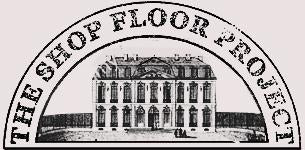A Feast of Auricula | Denise Allan

A hybrid of the alpine primula, with hundreds of cultivars, the auricula has several historical societies and countless admirers devoted to these dramatic little flowers. Denise Allan is the latest to sign up to the appreciation club. Working from her roof-top studio on the fifth floor of the old Warehouse where The Shop Floor Project was based at the time, the artist describes her interest in these flowers.

“I am not usually drawn to overly hybridised flowers, but it’s the very artificiality of these plants that attracts me. The development of the way the plants have been displayed throughout history seems to have removed them further and further away from nature, treating them as specimens and curiosities."
"One of the first documented ways to display them was to line up potted auricula along the centre of a table at a 17th century ‘shilling ordinary’ where diners could admire them as they ate. I’ve been inspired by perhaps the most well-known display, the ‘auricula theatre’; a shelved stage, painted with a dark backdrop (below left) .”

Auricula were mentioned by the 18th century Huguenot silk weaver’s of Spitalfields who incorporated them into designs for fabric (as shown above right).
“I remember the time myself when a man who was a tolerable workman in the fields had generally beside the apartment in which he carried on his vocation, a small summer house and a narrow slip of a garden at the outskirts of the town where he spent his Monday either in flying his pigeons or raising his tulips and Auricula.” John Thelwall 1795, Spitalfields silk mercer.
Auricula were renowned for their status and were grown for competition by flower fanciers at ‘Florists’ Feasts’, the precursors of the modern flower show. These events were recorded as taking place in Spitalfields and across the country in local halls and public houses with prizes such as a copper kettle or a ladle. After the day’s judging, the plants were all placed upon a long table where the participants sat to enjoy a meal together known as “a shilling ordinary” and to admire their exhibits.

Across Europe they were so popular that many large estates set up an auricula theatre with a stage, a curtain and seating. A flowering plant was brought from behind the curtain and placed on a structure for the audience to admire and applaud. The specimen was then taken away and a new one placed in front of the audience to great applause. At the end of the show the audience was invited to the wall to view the plants at close range.

Denise Allan invites the same inspection of these new printed specimens, taken from the original paintings on board and beautifully printed at our Fine Art Trade Guild printers in East London to museum quality specifications, on the finest quality archival, acid-free paper. Aquarelle Rag is a beautifully textured paper, similar to that of traditional watercolour. It's natural white tone highlights the colour intensity of different pigments, including blacks.

Each print is limited to an edition of 100 and signed and authenticated on the reverse. Display individually or create an Auricula Theatre with a whole wall of specimens.

